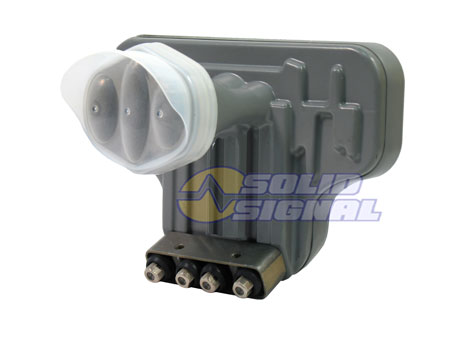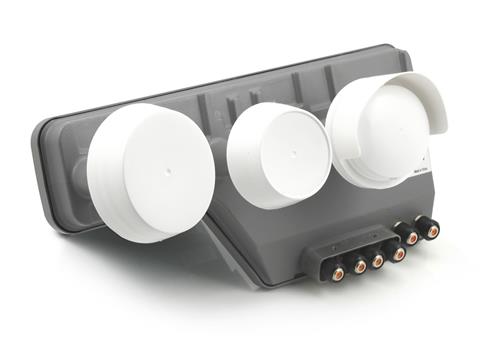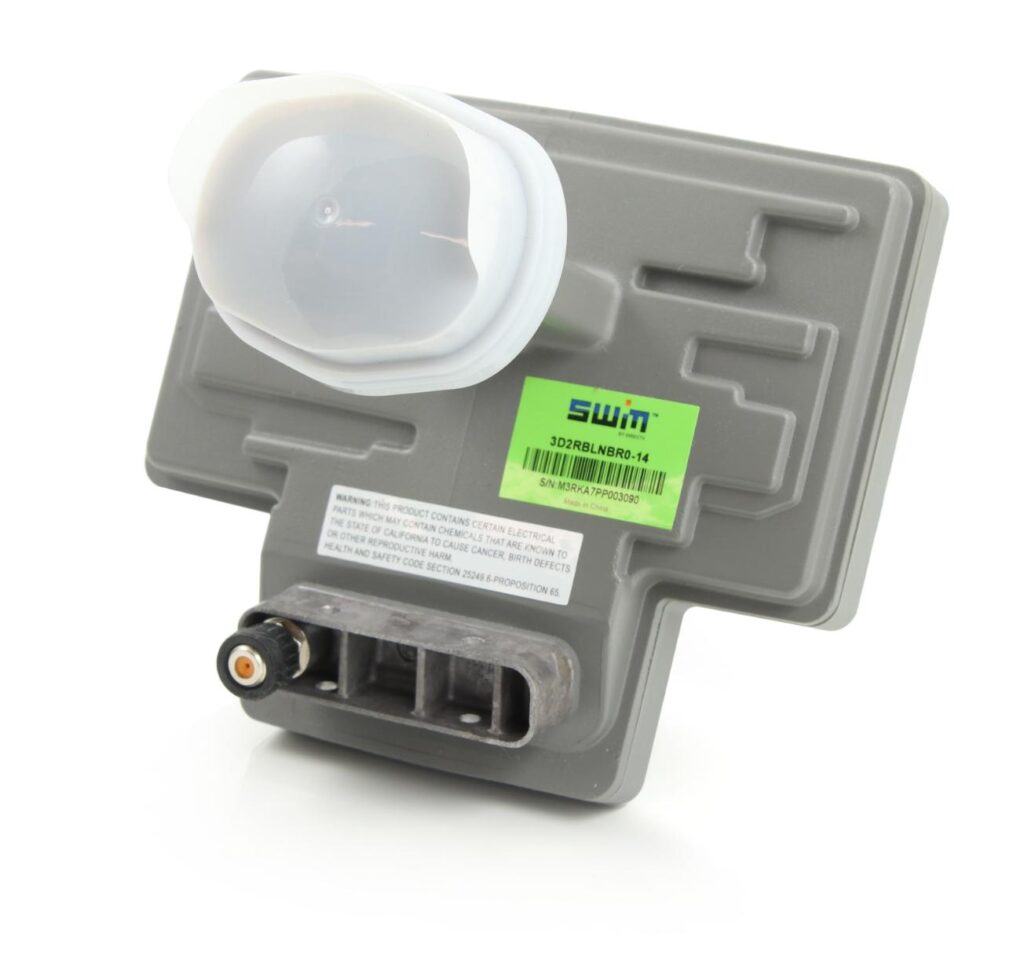I was recently contacted by a customer with an interesting question. He showed me a picture of his Slimline dish and said it had only two lines coming from it. He wanted to hook up more equipment, but didn’t know the best way to do it.
In order to answer him (and you) I need to explain a little bit.

DIRECTV’s HD dishes have been around since about 2003. They were redesigned in about 2008 into the Slimline version we know today. Before that there were a variety of different designs. One thing they all had in common was a set of four outputs. You can see them at the bottom of the picture above. This is the way that a lot of satellite dish LNBs looked for a long time.
There’s a good reason to have four outputs. The most important is that the satellite TV system used by DIRECTV uses a combination of voltage and “tone” to have four different types of signals over a cable. The line can carry either 13 volts or 18 (or something close to those numbers) and can either have a 22KHz signal on the line or not. If you know which of these four combinations you have on a line you can successfully tune to the channel you want.
In an old-school DIRECTV system a receiver, here’s what really happens when you choose a channel from the guide. The receiver looks up which combination of tone and voltage is actually needed. Roughly one quarter of the signals are on each combination. It sends a request to the dish for the right combination, and that’s what goes on the line.
This works great if you have only four receivers but if you need more than that you need a multiswitch. The multiswitch does the same thing, distributing the right combination of tone and voltage to a receiver. In order to do that, it needs full-time access to all four choices. Hence, four outputs.
As I said you can run an old-school DIRECTV system like this without an external multiswitch. If you only have two receivers, you can run two lines into the house. The other two connections aren’t used.
The problem is when you’re looking to expand. These 4-line LNBs haven’t been made in years. The replacement for commercial customers is this behemoth:

This is the LNB used for commercial installations. It requires six cables, not four, to be run from the dish. It also requires a SWM-30 multiswitch. There’s no way to connect a receiver straight to it. It just won’t work. So if you’re looking to connect a receiver straight to the dish, your only choice is to look on eBay or other sites for something used, and there’s no guarantee that it will work.
The better choice is just swapping in a new LNB that uses the modern SWM system.

This SWM-enabled LNB is a direct swap for an older 4-line LNB and has a built-in 13-tuner multiswitch. This is enough to run pretty much all the equipment that an average person is going to need. If you find yourself wanting to support more than 7 TVs at the same time, you can push this LNB to support 21 tuners, as long as you have no more than 13 of the older H24/H25 type devices and you power them up first.
Swapping in an LNB is really just a matter of unscrewing and disconnecting the old one, and reconnecting the new one. If you are going from “legacy” to SWM, you’ll only connect one line, or you can put a splitter outside and use all the lines that were previously connected. I generally recommend using a pencil to mark the dish’s position and all the adjustment screws in case you accidentally move the dish.
Our Ultimate Guide to Upgrading is totally free. It’s been downloaded over 70,000 times and it’s the total authority on choosing the right equipment. You’ll get all the information you need to do it all yourself including helpful links to the products you’ll need! If you’d like more information, call the experts at 888-233-7563 or fill our the form below.
The post “I only have two lines coming from my dish…” appeared first on The Solid Signal Blog.
Continue reading...
In order to answer him (and you) I need to explain a little bit.
How a Slimline dish used to work

DIRECTV’s HD dishes have been around since about 2003. They were redesigned in about 2008 into the Slimline version we know today. Before that there were a variety of different designs. One thing they all had in common was a set of four outputs. You can see them at the bottom of the picture above. This is the way that a lot of satellite dish LNBs looked for a long time.
There’s a good reason to have four outputs. The most important is that the satellite TV system used by DIRECTV uses a combination of voltage and “tone” to have four different types of signals over a cable. The line can carry either 13 volts or 18 (or something close to those numbers) and can either have a 22KHz signal on the line or not. If you know which of these four combinations you have on a line you can successfully tune to the channel you want.
In an old-school DIRECTV system a receiver, here’s what really happens when you choose a channel from the guide. The receiver looks up which combination of tone and voltage is actually needed. Roughly one quarter of the signals are on each combination. It sends a request to the dish for the right combination, and that’s what goes on the line.
This works great if you have only four receivers but if you need more than that you need a multiswitch. The multiswitch does the same thing, distributing the right combination of tone and voltage to a receiver. In order to do that, it needs full-time access to all four choices. Hence, four outputs.
But… two lines?
As I said you can run an old-school DIRECTV system like this without an external multiswitch. If you only have two receivers, you can run two lines into the house. The other two connections aren’t used.
The problem is when you’re looking to expand. These 4-line LNBs haven’t been made in years. The replacement for commercial customers is this behemoth:

This is the LNB used for commercial installations. It requires six cables, not four, to be run from the dish. It also requires a SWM-30 multiswitch. There’s no way to connect a receiver straight to it. It just won’t work. So if you’re looking to connect a receiver straight to the dish, your only choice is to look on eBay or other sites for something used, and there’s no guarantee that it will work.
The better choice
The better choice is just swapping in a new LNB that uses the modern SWM system.

This SWM-enabled LNB is a direct swap for an older 4-line LNB and has a built-in 13-tuner multiswitch. This is enough to run pretty much all the equipment that an average person is going to need. If you find yourself wanting to support more than 7 TVs at the same time, you can push this LNB to support 21 tuners, as long as you have no more than 13 of the older H24/H25 type devices and you power them up first.
Swapping is easy.
Swapping in an LNB is really just a matter of unscrewing and disconnecting the old one, and reconnecting the new one. If you are going from “legacy” to SWM, you’ll only connect one line, or you can put a splitter outside and use all the lines that were previously connected. I generally recommend using a pencil to mark the dish’s position and all the adjustment screws in case you accidentally move the dish.
Need to know more?
Our Ultimate Guide to Upgrading is totally free. It’s been downloaded over 70,000 times and it’s the total authority on choosing the right equipment. You’ll get all the information you need to do it all yourself including helpful links to the products you’ll need! If you’d like more information, call the experts at 888-233-7563 or fill our the form below.
The post “I only have two lines coming from my dish…” appeared first on The Solid Signal Blog.
Continue reading...

